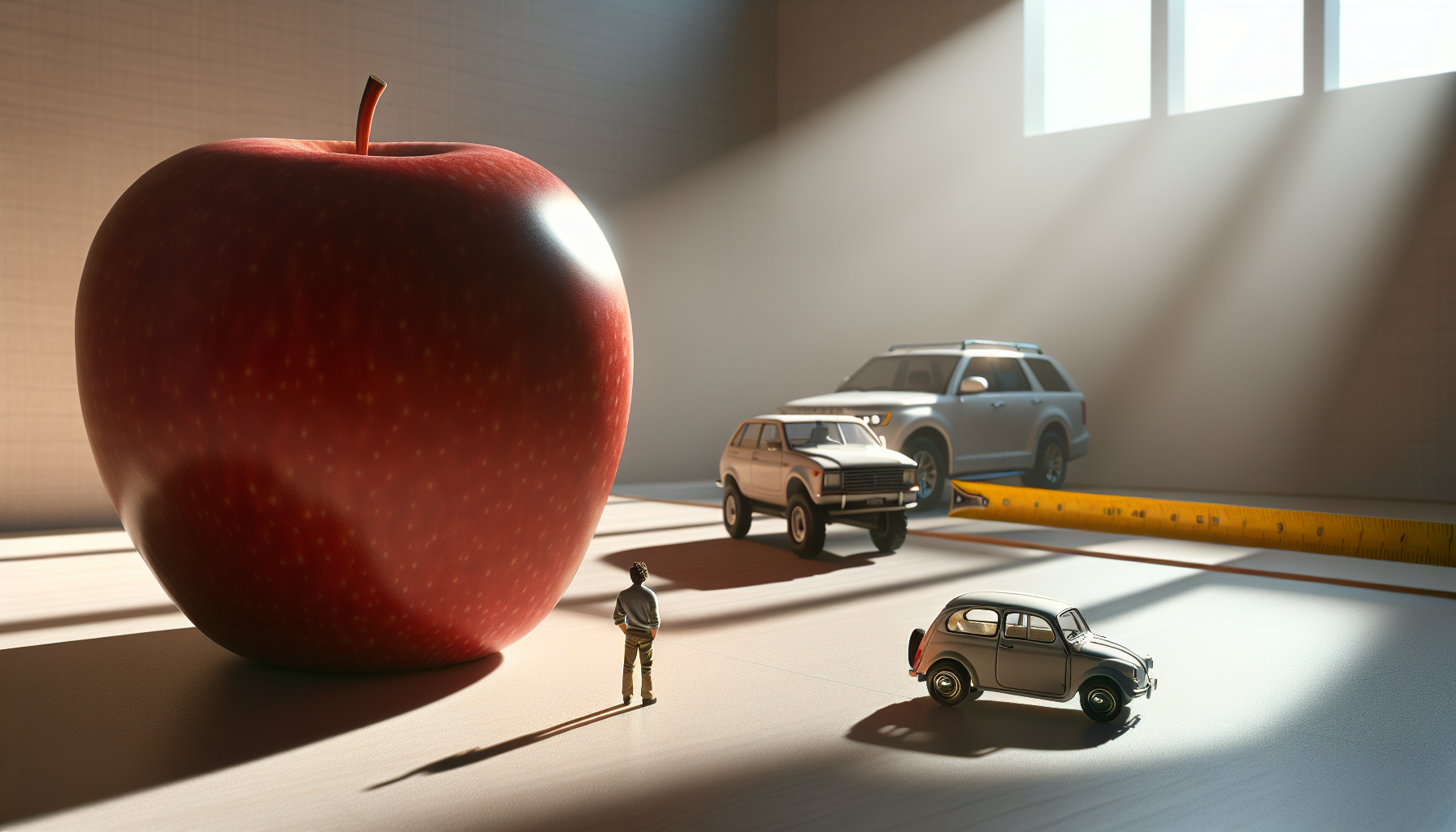Reklamy
In a world where appearances often guide our perceptions and decisions, the concept of size can be both a captivating and deceptive element. We encounter it daily, whether we’re assessing the value of a product based on its packaging, judging the impact of a work of art, or even in our own self-perception as we navigate through society. Size, in its many forms, wields a peculiar power over our understanding of reality, shaping how we interpret everything from the mundane to the magnificent. This blog post delves deep into the intriguing world of size deception, exploring how our minds can be misled by scale and how this phenomenon permeates various aspects of our lives. By unraveling the complexities behind misleading scales, we aim to provide you with a clearer understanding of the subtle influences that size exerts on our perception.
Reklamy
Understanding the Scale Deception Phenomenon
Reklamy
The concept of size deception plays a significant role in shaping our understanding of the world. It refers to the discrepancy between perceived size and actual size, which can lead to misunderstandings and misinterpretations of reality. This phenomenon can be observed in various aspects of daily life, from the way we perceive physical objects to the interpretation of data in charts and graphs. The consequences of such misperceptions can be far-reaching, affecting everything from consumer behavior to scientific research.
Size deception is often rooted in the psychological processes that govern human perception. Our brains rely on a range of visual cues to interpret the size of objects, such as perspective, context, and previous knowledge. These cues, however, can be manipulated or misread, leading to erroneous conclusions. For instance, an object may appear larger or smaller depending on its surroundings or the angle from which it is viewed. This is why artists and designers often use techniques like forced perspective to create illusions of scale.
The Psychological Roots of Size Deception
The human brain is a complex organ, designed to interpret and make sense of the myriad of stimuli it encounters. Size perception is one of the many ways our brain interprets visual information. The brain uses various cues, such as light, shadow, and perspective, to estimate the size of objects. However, these cues can sometimes be misleading. For example, the famous Müller-Lyer illusion demonstrates how line length can appear different based on the orientation of arrowheads at the ends of the lines, despite being equal in length.
Another classic example is the Ebbinghaus illusion, where a central circle surrounded by larger circles appears smaller than the same central circle surrounded by smaller circles. These optical illusions highlight how context can dramatically alter our perception of size. Understanding these illusions helps us recognize that size perception is not always a straightforward interpretation of reality, but rather a complex, context-dependent process.
Furthermore, cultural and individual differences can also influence size perception. Studies have shown that people from different cultures may interpret visual cues differently due to varying experiences and environmental factors. This cultural variance suggests that size deception is not only a universal human experience but also one that is influenced by personal and social factors.
Size Deception in Everyday Life
Size deception is not confined to theoretical discussions or optical illusions. It permeates many aspects of everyday life, affecting how we perceive and interact with the world around us. One of the most common areas where size deception plays a role is in consumer behavior. Product packaging, for instance, often uses deceptive size cues to create an impression of greater value or quantity than what is actually provided. This tactic can influence purchasing decisions, as consumers are naturally drawn to items that appear to offer more for their money.
In architecture and design, size deception can be used to create spaces that feel larger or smaller than they are. By manipulating elements like light, color, and layout, designers can alter a person’s perception of a space. A small room can be made to feel spacious with the use of mirrors and strategic lighting, while a large space can be made to feel intimate and cozy with the right furnishings and color schemes. Understanding these techniques can empower individuals to make more informed decisions about their living and working environments.
Moreover, size deception can influence our perception of time and distance. For example, long corridors or roads can appear shorter when lined with repetitive patterns or landmarks, tricking our brains into perceiving less distance. This principle is often employed in theme parks and shopping malls to keep visitors engaged and reduce perceived travel time between attractions or stores.
Implications of Size Deception in Advertising and Media
In advertising and media, size deception is a powerful tool for shaping consumer perception. Advertisers often use exaggerated visuals or misleading comparisons to create a sense of superiority for their products. For instance, a small car may be photographed in isolation to make it seem more spacious, or a food product might be displayed with oversized serving suggestions to imply greater value. These techniques can influence consumer preferences and purchasing behavior, often without the consumer being aware of the manipulation.
In the digital age, size deception has taken on new dimensions with the rise of social media and influencer marketing. Images can be edited and enhanced to create unrealistic body standards or lifestyles, contributing to societal pressures and self-esteem issues. Recognizing these manipulative practices can help individuals develop a healthier relationship with media and advertising, promoting more informed and critical consumption of content.
Size Deception in Data Visualization
Data visualization is a critical component of how information is communicated in today’s world. However, size deception can easily occur in this context, leading to misunderstandings and potentially misleading conclusions. Misleading graphs and charts are common pitfalls in data presentation, where scale manipulation can exaggerate or downplay significant findings. This is particularly relevant in fields like economics, health, and politics, where data-driven decisions have far-reaching impacts.
Consider a bar chart that uses an altered scale to make differences appear more pronounced than they are. Such visual distortions can skew perception and interpretation, leading viewers to draw inaccurate conclusions. Similarly, pie charts can misrepresent proportions if the segments are not accurately scaled, misleading viewers about the distribution of data points.
To help illustrate the potential impact of size deception in data visualization, consider the following comparison:
| Misleading Representation | Accurate Representation |
|---|---|
|
|
By understanding these common pitfalls, individuals can become more discerning consumers of visual data. It is crucial to scrutinize the scales and representations used in charts and graphs, questioning the integrity of the data presentation.
Best Practices for Avoiding Size Deception
To combat size deception in data visualization, certain best practices should be adopted. Firstly, using a zero baseline in bar charts ensures that differences in data are accurately represented. Secondly, maintaining consistent scales across multiple visualizations allows for fair comparisons. Thirdly, providing context and labels helps viewers understand the scope and limitations of the data being presented. Lastly, transparency about data sources and methodologies builds trust and credibility with the audience.
Educating oneself about these practices can enhance data literacy and empower individuals to make more informed interpretations of visual information. By advocating for accuracy and transparency in data visualization, we can promote a culture of informed decision-making and critical analysis.
Concluding Thoughts on Size Deception
The phenomenon of size deception, while often subtle, has profound implications for our understanding of the world. Whether encountered in everyday life, media, or data visualization, size deception challenges us to question our perceptions and seek out the truth. By recognizing the cues and contexts that influence our size perception, we can become more aware of the manipulative tactics used in advertising, design, and data presentation.
As we navigate an increasingly visual world, developing a critical eye is essential for discerning fact from illusion. This involves not only understanding the psychological mechanisms behind size deception but also advocating for transparency and accuracy in the information we consume. By doing so, we can foster a more informed and discerning society, capable of making sound judgments based on a clear understanding of reality.
For a deeper dive into the intricacies of size deception, consider watching the video below, which explores the fascinating world of optical illusions and their impact on perception:
Video Recommendation: “The Art of Optical Illusions” by the channel SmarterEveryDay

Wniosek
Conclusion: Unveiling the Impact of Size Deception in Perception and Reality
In this exploration of “Size Deception: Unraveling the Truth Behind Misleading Scale in Perception and Reality,” we have journeyed through a nuanced understanding of how size and scale can significantly influence human perception and the reality we construct around us. Throughout this article, we have delved into several critical aspects that highlight the power and pitfalls of size deception.
Firstly, we examined how our brains are wired to interpret size as a marker of importance and dominance. This inherent cognitive bias leads us to make quick judgments based on the size of objects, people, and even abstract concepts. The implications of this bias are profound, influencing everything from marketing strategies to interpersonal relationships. For instance, in marketing, larger packaging or images can create a perception of greater value or quality, even if the actual product remains unchanged. This phenomenon is brilliantly exploited in advertising, where visual scale can manipulate consumer preferences without altering the core attributes of the product.
Next, we analyzed the role of context in size perception. It’s fascinating how the environment can alter our perception of size and scale. The same object can appear vastly different depending on its surrounding elements. This is not merely a trick of the eye but a deep-rooted psychological effect where our brain processes size relative to the context provided. This aspect of perception has significant implications in fields like architecture and design, where the scale of structures can be manipulated to evoke specific emotional responses or functional interpretations.
Moreover, the article shed light on the ethical dimensions of size deception. While manipulating scale can be used to enhance user experience or aesthetic appeal, it also raises questions about ethical boundaries. For example, in digital media, altering the scale of images or videos can mislead viewers, fostering false narratives or unrealistic expectations. This becomes particularly concerning in the context of social media, where such practices can impact self-esteem and societal standards.
We also touched upon the fascinating world of art and illusion, where artists throughout history have played with size and scale to challenge perceptions and create experiences that transcend the ordinary. From the grandeur of Renaissance art to contemporary installations, artists have continually exploited size deception to evoke wonder, challenge norms, and engage viewers in deeper reflections.
The discussion extended to the practical applications and implications of understanding size deception in everyday life. Recognizing how scale influences perception can empower individuals to make more informed decisions, be it in personal development, consumer behavior, or professional contexts. By being aware of these biases, one can critically assess situations, advertisements, or products, thus making choices that align more closely with personal values and needs.
In concluding, the exploration of size deception underscores the intricate interplay between perception and reality. It reveals the complexity of human cognition and the subtle ways our understanding of the world can be shaped or distorted. As we become more aware of these dynamics, there is a powerful opportunity to apply this knowledge positively, both in personal growth and societal development.
To further enrich your understanding and explore this topic, I encourage you to delve into additional research. Some valuable resources include articles from Psychology Today, which offers insights into cognitive biases and perception, and Harvard Business Review, which often explores consumer behavior and marketing strategies.
As you reflect on these insights, consider how you can apply this knowledge in your daily life. Whether it’s becoming a more discerning consumer, challenging your perceptions in interpersonal interactions, or simply appreciating the art and science behind size and scale, the possibilities are vast.
Finally, I invite you to share your thoughts and experiences related to size deception. Have you noticed how scale influences your perceptions? How do you think this understanding could change your interactions or decisions? Share your comments and insights below! Your engagement not only enriches the conversation but also contributes to a broader understanding of this intriguing subject.
Thank you for embarking on this journey through the captivating world of size deception. Let’s continue to unravel the mysteries of perception and embrace the potential for more informed, conscious interactions with the world around us. 🌟
Toni Santos jest kartografem cyfrowym, myślicielem wizualnym i kuratorem tego, co cudownie dziwne. Na Aysapp, zanurza się w dziki świat dziwaczne mapy, wyobrażone geografie i alternatywne rzeczywistości kartograficzne, oferując świeżą perspektywę tego, jak postrzegamy — i odczuwamy — świat wokół nas.
Jego praca opiera się na przekonaniu, że mapy to coś więcej niż narzędzia nawigacyjne. Są portalami do percepcji, pamięci, wyobraźni, a nawet mitu. Od zniekształconych map historycznych po surrealistyczne formy terenu, atlasy spiskowe i kreację świata generowaną przez sztuczną inteligencję, Toni tworzy i kolekcjonuje mapy, które stanowią wyzwanie dla logiki i pobudzają ciekawość.
Mając doświadczenie w opowiadaniu historii, sztuce i eksploracji symboli, Toni używa Aysapp jako platformy do ujawniania zapomniane miejsca, niewidzialne granice i wyobrażone na nowo rzeczywistości. Jego dzieła stawiają pytania takie jak: Co by było, gdyby świat stanął na głowie? A co, gdyby mapy przekazywały prawdę emocjonalną, a nie geograficzną?
Jako twórca stojący za Aysapp, ma misję do wykonania wzbudzać ciekawość, zachęcają do kreatywnego myślenia i eksplorują połączenie wyobraźni, kultury i opowieści przestrzennych — jedna dziwna mapa na raz.
🌀 Jego kartograficzny wszechświat eksploruje:
-
Nierealne, ale znaczące krajobrazy
-
Emocje, pamięć i mit jako geografia
-
Mapy, które zniekształcają obraz, by ujawnić ukryte prawdy
Niezależnie od tego, czy jesteś fanem krain fantasy, kolekcjonerem map, ciekawym świata podróżnikiem czy osobą lubiącą to, co niezwykłe, Toni zaprasza czytelnika do celowego zagubienia się w najbardziej niezwykłych zakątkach kartograficznej wyobraźni.




